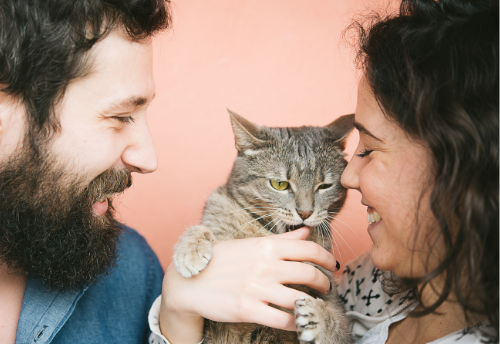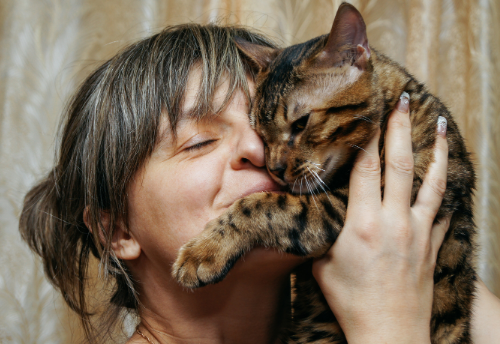1-877-961-9161
1-877-961-9161

Cats can make the most wonderful pet for the right person, but if you happen to be allergic to one, adopting a frisky feline into your home can be a real challenge - but not an impossible one. If you already have a kitty in the house and are experiencing allergy symptoms you should ask your doctor to do an allergy test.
Most people with mild allergies will have one of these symptoms that can develop within minutes or even a few hours after exposure:
Some people have severe allergies that result in lower blood pressure, allergic asthma attacks or even shock. But these are not common. Even if you have had a cat for a while and just developed these symptoms, ask for an allergy test that checks for cat allergies. Even if you do test positive for having cat allergies, you may not experience symptoms right away, or ever. However, if you are having some of these symptoms, even if you have had your kitty for a while you could still have developed a new allergy, and your cat may be part of the cause.
If it does turn out that you have are allergic to cats, you are not alone. Did you know that 10% of the US population have allergies related to pets, with cat allergies being twice as common as dog allergies? If you are longing to have a cat but are one of those 10%, they key is to understand what is causing your allergic reaction - and believe it or not, it’s not the fur.
People with cat allergies react to a protein in the animal's saliva, skin, and urine. The allergen collects on the cat's fur when the animal licks itself and comes off in tiny flakes of skin that stick to walls, carpet, and furniture or stay in the air. A cat's lick or scratch can also cause skin welts or itchiness. In the nose and lungs, the protein causes itchy, watery eyes and nasal congestion and can lead to asthma. These allergens can even remain long after the cat is gone.
The other variable is your immune system. As with all allergies, an individual's immune system may see a harmless irritant as a threat, and will attack the body to try to get rid of it. Even those who are confirmed to be allergic may be affected differently. Maeve O'Connor, MD, a clinical immunologist in Charlotte, N.C., says one person can hold a cat and have no symptoms, while another has an asthma attack standing near a person with cat dander on his or her clothes.
How to Cure Your Allergy to Cats

One way to reduce the amount of cat dander in your environment is to groom your cat on a regular basis. Keeping the area where your cat spends a lot of time such as their favorite chair or sofa, and especially the cat litter box, clean can help.
Another answer could be a hypoallergenic cat. While scientists can’t quite explain why some cats cause less of an allergic reaction, some possible theories suggest that some cats secrete less of the protein that causes the allergen, some cats put out less saliva, and some cats produce less dander. But all cats make the allergen in some form -- and a tiny amount can cause a lot of symptoms, depending on how clean you keep your house and how often you're around the animal. "Even a cat that has a little bit of allergen can cause allergy if you have enough exposure to it," says Robert Zuckerman, MD, an allergy and asthma specialist in Harrisburg, PA.
Still, some allergy sufferers find their symptoms don't flare up around certain cats. Maybe they can tolerate domestic shorthairs but not oriental breeds -- or vice versa. Some can pet a white cat but start sneezing as soon as they touch a dark gray or black one. Many patients report they can only handle being around Siberian cats.
Most research offers only clues to explain why people are more allergic to some cats and not others, not answers. However, if you are looking for a cat that may cause less issues, consider the following:
Here are is a list of some hypoallergenic cat breeds and why they seem to be best suited to those with cat allergies. However, regardless of the cat you plan to get, it is suggested that you first spend some time around that particular type of cat to gauge your specific reaction to it.

The Sphynx cat is famed for being hairless which gives it a unique look but ensures that the allergenic proteins in the cat’s saliva can’t get trapped in a Sphynx cats fur.
The LaPerm cat has a unique curly coat that may help reduce the spread of dander around your home. Many people with allergies do well with LaPerms in their homes.


Most cat’s fur is arranged in 3 layers; a top ‘guard’ hair, a middle ‘awn’ hair and a bottom ‘down’ hair. The Cornish Rex possesses only the bottom undercoat of down hair which means that they are not only very soft but they have a lot less hair and therefore shed a lot less hair; meaning that they are less likely to cause an allergic reaction.
The Devon Rex shares the same coat type as the Cornish Rex possessing only the soft down hair that makes up most cat’s undercoats. However, the Devon Rex has even less hair than the Cornish Rex and also sheds very little. As with the Cornish Rex this means they are less likely to cause an allergic reaction.


Javanese cats also have just one of the three typical layers of coats common to cats. But instead of having only an undercoat like the Cornish and Devon Rexes, the Javanese has just a top coat, which means less shedding and dander to spread around your home.
Oriental Shorthairs have a short, fine coat and shed very little. For best results, brush your Oriental Shorthair regularly to help remove any loose hairs to further reduce the amount of hair it drops.


Russian Blues don’t have any special coat qualities that make them hypoallergenic but they do produce less Fel d 1 - the protein that cats secrete from their skin which a lot of allergy sufferers are allergic to.
Similar to the Russian Blue, the Balinese cat produces less Fel d 1 which means that they are less likely to cause an allergic reaction.


This one may surprise you… When you see a Siberian with its beautiful long coat it can be easy to think that this breed of cat will be a nightmare for allergy sufferers. However, like the Russian Blue and Balinese, the Siberian’s skin produces less Fel d 1 than most other breeds so is considered hypoallergenic.
Many breeders and owners make claims that the Bengal has hypoallergenic properties. Although there is no evidence that they produce less Fel d 1 protein, the main argument for why they are supposedly less allergenic is that their short pelt-like coat sheds a lot less hair than the average cat and so is less likely to cause an allergic reaction.

Whatever cat you choose, make sure it is one that fits your family style and is one that you will be comfortable to be around. If you're happy, your pet will be happy too.